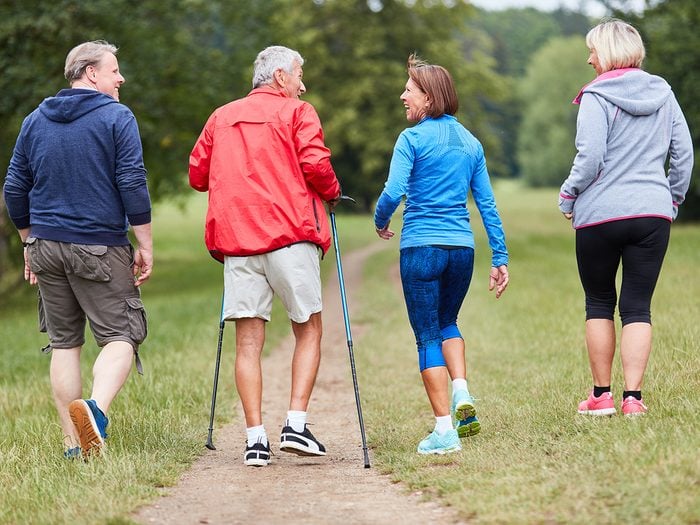
The benefits of walking every day
Twenty summers ago, Nancy Duguay stood at the side of a soccer pitch in Campbellton, New Brunswick, watching her 11-year-old son sprint back and forth, and wished she had a cigarette.
Duguay, then 39 and a cardiac-rehab nurse, was trying to quit smoking after having the habit for more than half her life. She’d sneaked her first cigarettes from her parents’ packs as a teen and hadn’t stopped since. With her hands empty as she waited for her son’s practice to end, the urge for a puff gnawed at her.
Behind the field, the heavily forested Sugarloaf Mountain stood guard. As a kid, Duguay and her friends regularly hiked the mountain and picnicked on its peak.
Then an idea struck her: walking instead of smoking. She told another parent that she would be back in time to pick up her son and then set off for the mountain. “In just my regular sneakers, a pair of shorts and a T-shirt,” she remembers.
Duguay’s heart pounded as she climbed, and she stopped often to rest. When she arrived at the top, she took in the view that sweeps over the city and across the river to the rolling hills of the Gaspé Peninsula.
“I just felt so good,” says Duguay. “My natural endorphins kicked in, and the craving was gone.”
Almost every day since, she has gone for a walk—and the habit has changed her life. Not only did she quit smoking, but her resting heart rate dropped from 80 beats per minute to 60. The ritual has given her a lot more, as well: stress relief, mental-health management, and a sense of community.
“There’s a psychological and physical need to do it now,” she says. “I want to keep healthy and keep moving.” Keep reading to discover more incredible health benefits of walking every day.

It’s good for your body
A growing body of research confirms what Duguay discovered: there are enormous benefits in walking every day. According to a report from the Canadian Academy of Sport and Exercise Medicine, walking for 150 minutes a week can reduce the risk of most major chronic diseases by 25 to 50 per cent. In fact, light to moderate exercise has been found to be more effective than medication during rehabilitation after a stroke. For prevention of diabetes and as a secondary treatment of heart disease, walking is equally as effective as taking drugs.
In 2019, a Journal of Clinical Oncology study reported that a small amount of physical activity—such as taking a brisk walk for 20 minutes or more a day—is linked to a lower risk of seven types of cancer. Meanwhile, more walking means better sleep, too. In a recent study of middle-aged men and women, the participants who took more steps during the day slept better at night.
“We need to start thinking about walking as a healthy activity,” advises Dr. Jane Thornton, a family physician in London, Ontario. She advocates for the idea that we consider physical activity as medicine—a philosophy that grew out of personal experience. Thornton was a shy, sedentary 14-year-old when she signed up for a beginner’s rowing class in Fredericton. While her physical fitness improved, a new social circle opened to her and her grades went up. Thornton went on to become a world-champion rower and represented Canada at the 2008 Olympics.
A few years after competing in the Olympics and shortly before retiring from sport, she enrolled in medical school. She was surprised by the lack of information provided to physicians-in-training about the benefits of exercise. “For whatever reason, there just wasn’t any content at all on physical activity,” she says.
In 2014, Thornton started working on a campaign with the Canadian Academy of Sport and Exercise Medicine to get doctors to prescribe physical activity for patients—including walking. “I don’t think it’s a panacea for everybody, but it is one of the easiest, best solutions we have at our disposal,” she says.
One significant reason that walking is so good for us is fairly straightforward: when we move, our hearts work harder to transport blood to the working muscles and organs. That repeated effort strengthens the heart muscle, making it pump more efficiently at all times, sending blood around the body with fewer beats per minute. Exercise also improves the function of blood vessels, with one analysis reporting that aerobic exercise can improve our vascular health.
Walking helps build other muscles, too, especially in the lower body, and improves balance and strength. Physiotherapists like to say “Motion is lotion.” When our bodies don’t move enough, they stiffen. Ligaments, tendons and muscles tighten when they’re not used, causing pain in joints. For back pain, especially, movement can help. When we walk, we activate the muscles that run along the spine, strengthening them. “Pain and function improve just by putting those muscles into play,” Thornton says.
Hospitals have also begun to embrace the value of walking. At Mount Sinai in Toronto, older patients weren’t always encouraged to get up from bed because of the risk of falling. About ten years ago, that changed. Assisted by doctors, nurses and volunteers, patients are now prompted to walk to the bathroom, explore the hallways and get out of bed to eat their meals.
Since that change, fewer patients require catheters and suffer pressure ulcers. On average, they spend less time in the hospital. “Every day that an older person is in bed, they lose five per cent of their physical functioning,” says Dr. Samir Sinha, Mount Sinai’s director of geriatrics. “So getting them up and walking can reduce the chance that grandma might not be able to return home.”
Here’s why you might try Nordic walking, the fitness phenomenon that delivers a full-body workout.

It’s good for your mental health
One of the most important benefits of walking every day is that it’s equally beneficial for our mental health. For Duguay, walking helped her through some of the toughest periods in her life. When her mother died of cancer, Duguay turned to the mountain to walk through her pain. “I would cry all the way up the mountain,” she remembers. In this way, walking became her antidepressant.
According to a 2019 study led by researchers at Harvard University, people with a genetic risk for depression are less likely to struggle with the condition if they exercise—even performing light physical activity like walking.
Walking also reduces the risk of dementia and Alzheimer’s disease. In 2019, the World Health Organization released new guidelines on dementia prevention, and its top recommendation was to get more exercise.
“We’ve always known that exercise is good for your heart, but we’re now making a connection between exercise and cognitive improvements,” said Dr. Saskia Sivananthan, chief research & knowledge, translation and exchange officer at the Alzheimer Society of Canada.
Although that link isn’t yet fully understood, Sivananthan says there are a number of possible explanations: increased blood flow to the brain increases the organ’s cell growth; physical activity stimulates certain hormones that improve well-being and may reduce brain-matter loss linked to cognitive function; and walking might also reduce inflammation in the brain.
Meanwhile, one study from McMaster University has shown that aerobic activity that incorporates intervals of higher-intensity exertion improves memory function. According to Dr. Jennifer Heisz, who worked on the research, walking promotes production of a protein, BDNF, that spurs growth of new brain cells. These cells help us create high-fidelity memories—“the type we need everyday to locate our car in a busy parking lot and recognize a friend in a crowd,” she said.
Discover more science-backed ways to boost your brain power.

It’s good for your social life
Jim Button, a 56-year-old entrepreneur in Calgary, was diagnosed with kidney cancer in 2014. He underwent successful surgery but, less than two years later, he learned that his cancer was back, had spread and was terminal.
Button knew that exercise would help keep him as healthy as possible. He started walking five kilometres a day. Before his diagnosis, he’d meet with business contacts and friends at coffee shops. Now he asks them to join him on a walk. Every day over the last three years that his health has allowed, Button has gone for a walk, all the while expanding the range of his walking partners—he regularly strolls with strangers who reach out to him seeking business advice, or people recently diagnosed with cancer and other illnesses.
“I’ve discovered that not a lot of people go for walks,” Button says. “And when they do, it opens up their mind to be a bit more honest about whatever challenge they would like to talk about.” On some walks, he says, conversation never slows. On others, little is said but much is shared, even silently.
Inspired by Button’s strolls, Dr. Lisa Bélanger—founder of Knight’s Cabin, a Canadian charity for cancer survivors and their supporters—helped found an initiative in Calgary called Walk It Out. The program is like other peer support groups, but participants walk outside while they share their experiences with the disease. “More than in a sit-down, face-to-face meeting, walking seems to allow a conversation to flow naturally,” she says.
Bélanger, who is an expert in behavioural medicine, adds that walking has the power to undo negative thought patterns. “If you’re thinking about a problem and you go for a walk, the activity in your brain changes, and you learn and think better,” she says.
Like Button, New Brunswick’s Nancy Duguay has corralled her community around her daily walks. The more she walked, the more people around her saw the benefits and started doing it, too. Her husband, Roger, began to accompany her on hikes on their holidays. And about seven years after Duguay’s first walk up Sugarloaf Mountain, her sister decided to try it. Now she, too, takes a walk every day, and they often go together. A small community of walkers has formed around them.
“We’ll meet people coming down and say, ‘This was a tough one today. It was really slippery, but boy, you know, it’s worth it.’”
Has your daily stroll become a tired routine? Here’s expert advice on how to make walking more fun.

Put your best foot forward
To experience all the benefits of walking every day, treat it like a workout, says Calgary-based personal-fitness trainer Korey Samuelson:
- Walk with an upright posture, your head held straight, not looking up or down. Keep your gaze about five metres ahead.
- To move faster, put more bend in your elbows.
- Swing your arms forward and back; moving them across the body isn’t efficient. “Just like sprinting, arm movement is important for strong walking,” says Samuelson.
- When your lead foot lands on the ground, roll from heel to toe. Your footwear should be pliable enough to allow the natural movement across your foot.
- To speed up, increase your strides per minute rather than elongating your strides. More steps per minute means you’ll travel further, faster.
- Use Nordic walking poles to increase your heart rate and burn more calories.
- Intersperse intervals of brisk walking with periods at a slower pace.
Now that you know the benefits of walking every day, find out what can happen when you start walking 10,000 steps a day.